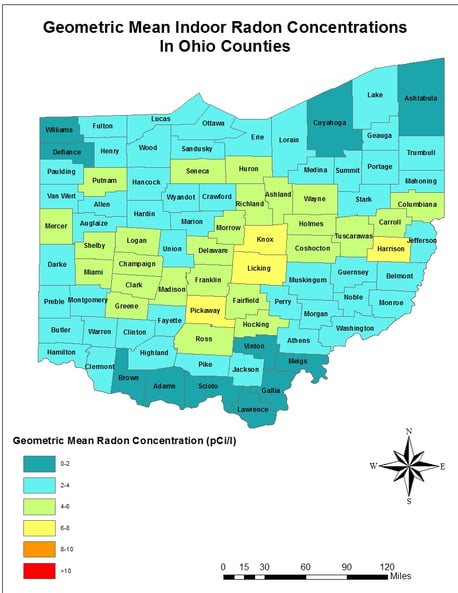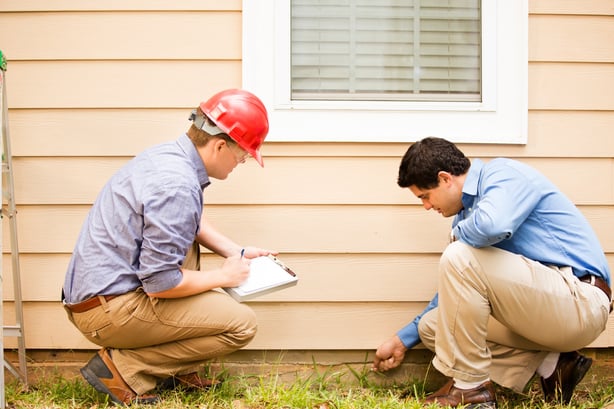When searching for a new home, safety is important.
But what about the danger inside the house?
What many people don't realize is that safety comes in many forms.
Safety isn't just about low neighborhood crime rates and good locks on the doors.
What's inside of your home matters just as much as what's outside.
And in Ohio, there may be a silent killer inside your home that you don't know about.
That silent killer is radon.
Radon is a naturally occurring radioactive gas emitted from the ground.
Radon is colorless, tasteless, and odorless.
When you're outside, radon exposure to very low concentrations is impossible to avoid and generally harmless.
However, after entering through joints in walls, basement floors, foundations, and other openings, radon may concentrate at dangerous levels when it gets trapped in your house.
There are other ways for radon to be present in your home. Read our blog post: "Is There Radon in My Granite Countertops?"
Exposure to high levels of radon gas in your home can cause lung cancer.
Radon is the second leading cause of lung cancer in the United States. It is responsible for an estimated 21,000 deaths each year.
So how much of a threat is radon in Ohio?
In the article below, we will discuss the average radon levels in an Ohio home and what to do about elevated levels.
Table of Contents
RADON IN OHIO HOMES
Ohio has relatively high natural concentrations of uranium from glacial deposits and shale, which produce radium and radon during radioactive decay.
The EPA's current radon action level, meaning if your home is above this level, you need to take immediate action, is four picocuries of radon per liter of air (4 pCi/L).
Most counties and homes in central Ohio have high radon potential, with a predicted average indoor greater than the EPA action level.
According to a study cited by the Ohio Department of Natural Resources Department of Geological Survey, about 38% of the 88 counties have an average indoor radon level above 4.0 picoCuries per liter.
Licking County's average was astronomical, above 8.0 pCi/L, double the action level set by the EPA.
Seven counties, including Carroll, Fairfield, Franklin, Harrison, Knox, Pickaway, and Ross, had average indoor Radon concentrations between 6 and 8 pCi/L.
The amount of radon in the soil beneath your house will depend on the soil's chemistry, which will vary from one house to the next.
Radon levels in the soil can range from a few hundred to several thousands of pCi/L in the air.
The amount of radon that is able to escape the soil and enter your house depends on the weather, soil porosity, soil moisture, and the suction within the home.
RADON TESTING
There is no way to know the radon levels in your house without a specific radon testing device.
Homes in high-risk areas may have low radon levels, while homes in lower-risk areas may be high.
Your neighbor could have low levels, while you, right next door, could test high.
The Ohio Department of Health suggests that all owners test their homes for radon, and the law permits homeowners to do their testing.
Inexpensive short-term radon tests last between two to 90 days, and a long-term test kit that lasts more than 90 days is available.
If you don't want to test your house yourself, you must contact a licensed radon contractor to install a continuous radon monitor to check the levels in your home.
A low-cost radon test is available through the Department of Health's Indoor Radon Program.
There are even discounted radon tests available in many counties, made possible through grants from the Indoor Radon Program.
Qualified RADON PROFESSIONALS
The best way to get your house tested is by hiring a qualified radon testing contractor.
Not only can they test your house, but they can help you with radon mitigation if necessary.
Chapter 3723 of the Ohio Revised Code requires that all radon companies and personnel involved with testing and installing radon reduction systems must be licensed.
The Radon Licensing Program at the Ohio Department of Health manages the licensing program.
This Ohio program covers contractors, specialists who design and supervise the installation of systems, radon testers, radon laboratories, and the companies that provide radon training.
Also, the program approves training for each of these classifications and inspects/audits their activities.
The Radon Licensing Program maintains a database of licensed radon testers and contractors.
Contact RADON ELIMINATOR
If you live in Ohio and you'd like to have your house tested for radon, contact our professional radon company to schedule a discounted radon test.
Radon Eliminator is licensed through the state of Ohio, and their Mitigation License number is RC202.
If you want to ensure that your home has a safe level or radon gas, you'll need a company to perform an accurate radon measurement to ensure your home is safe from the dangers of radon.
Click the link below to schedule an appointment to check the concentration of radon in your home today.







